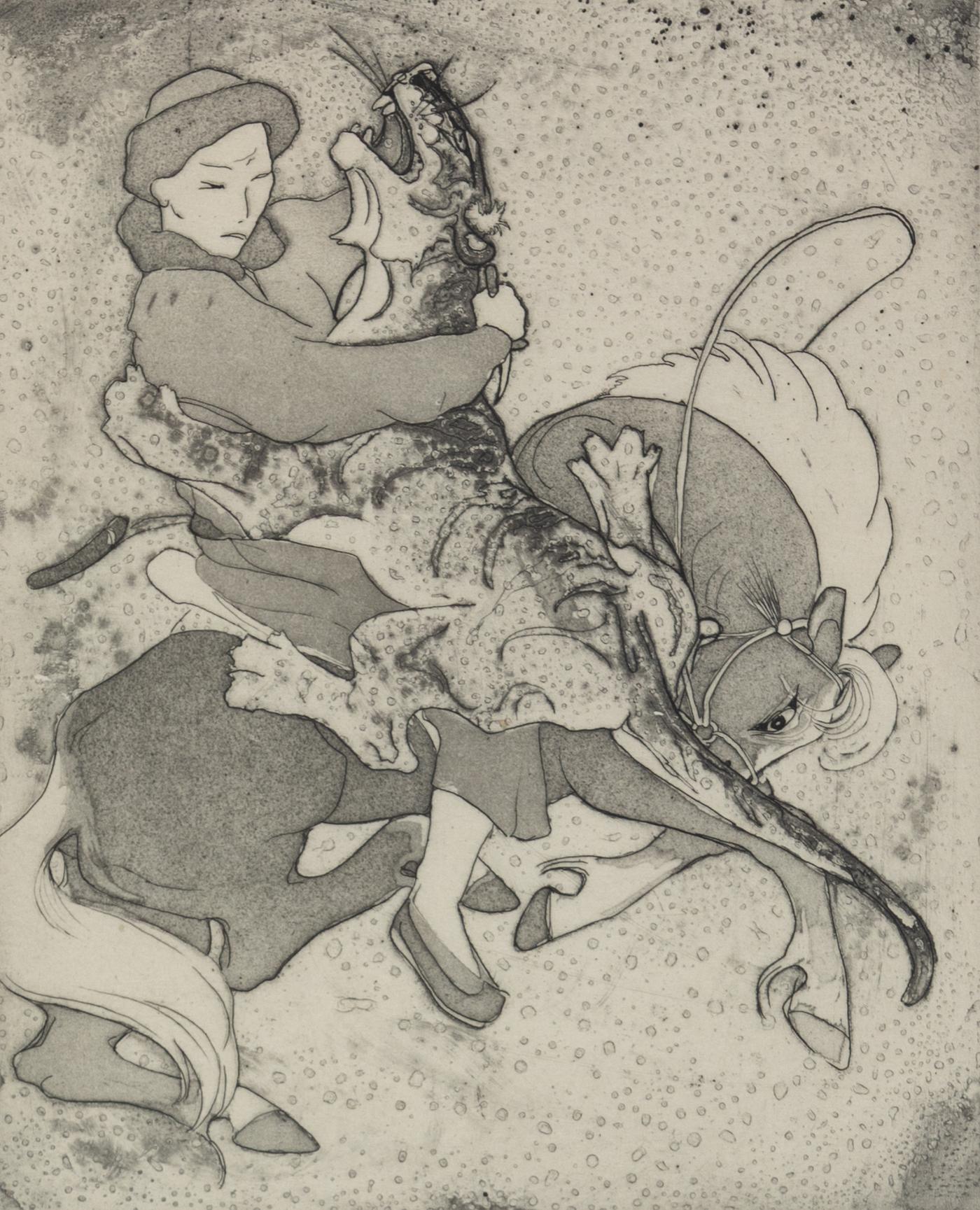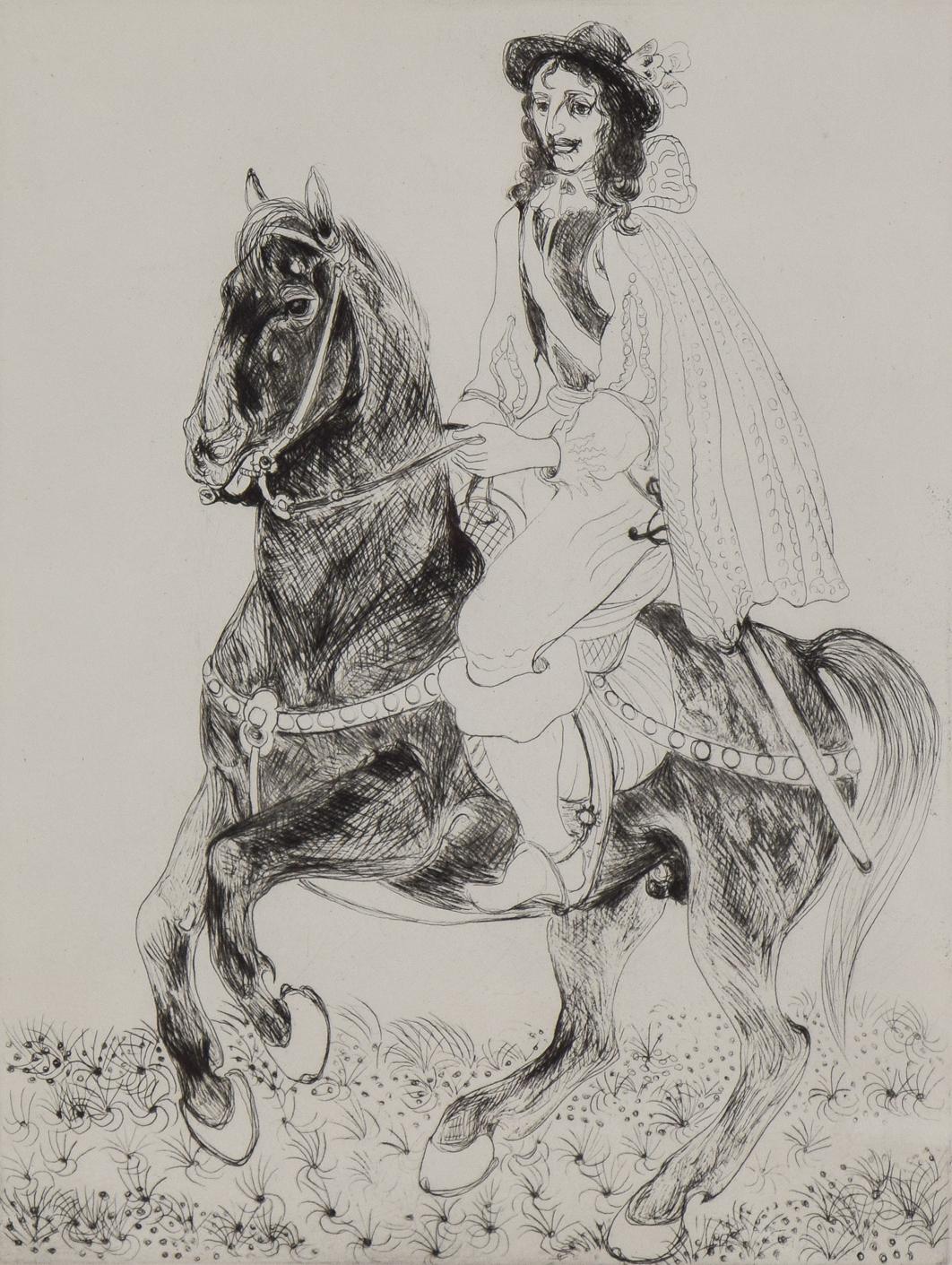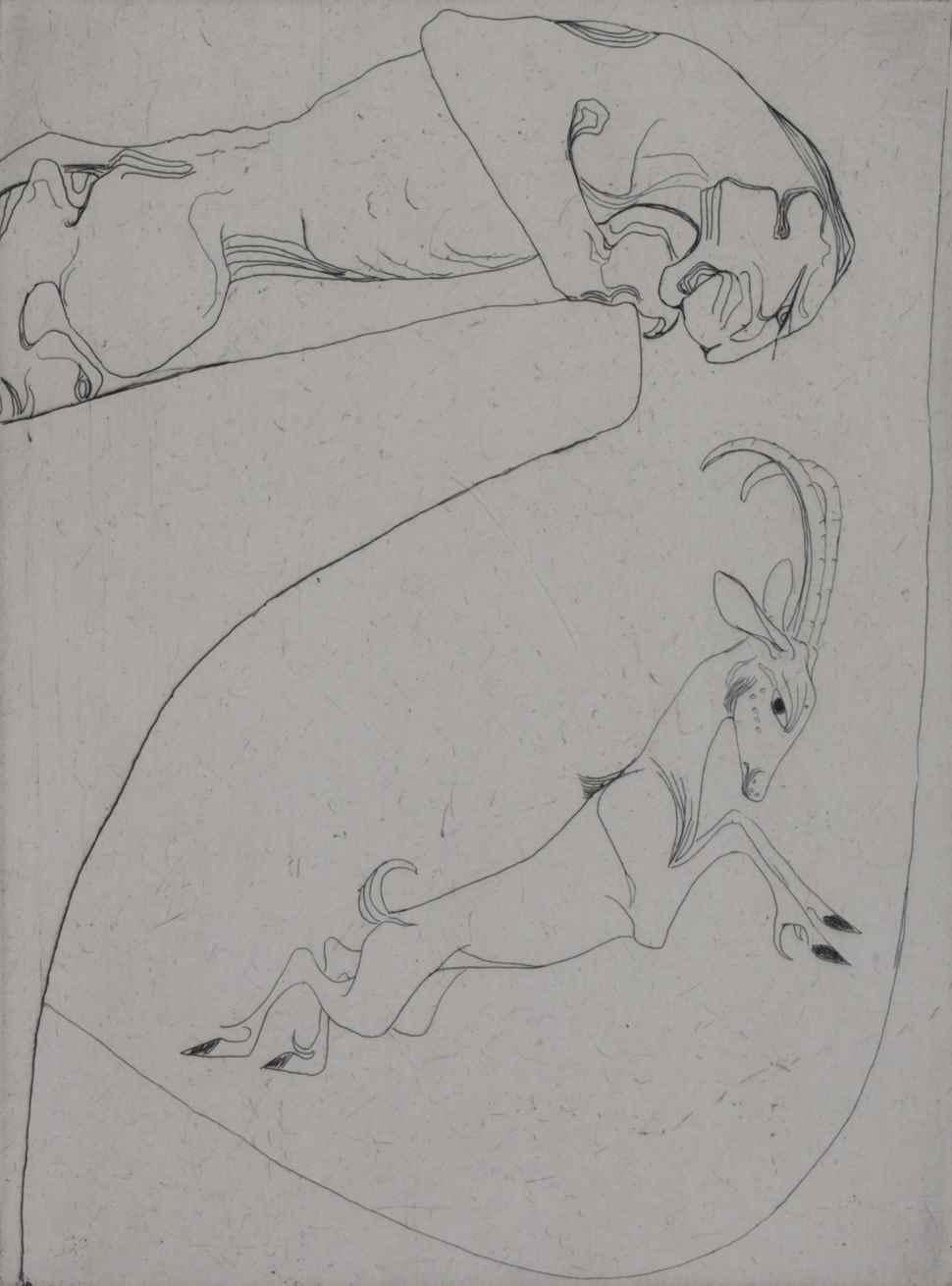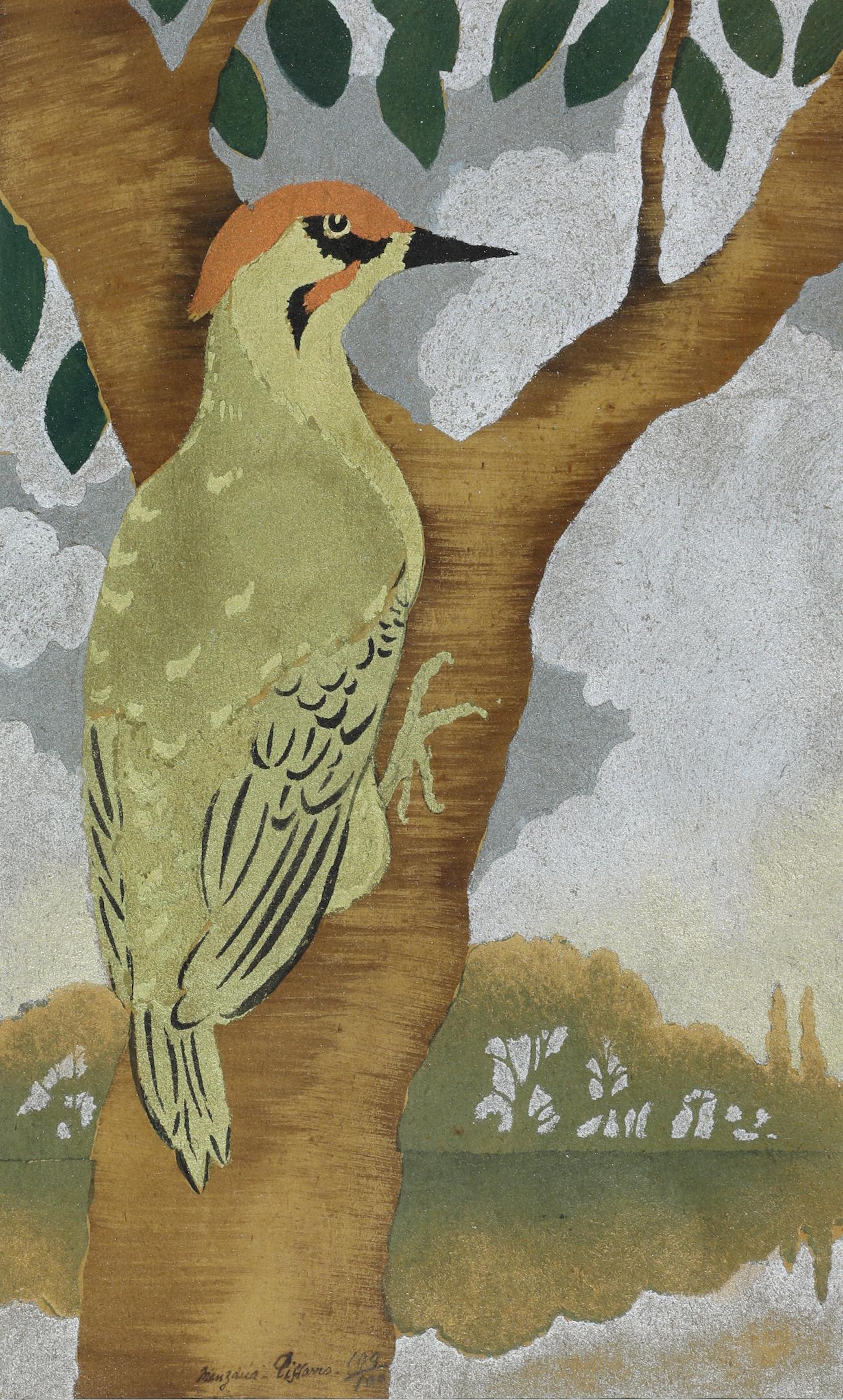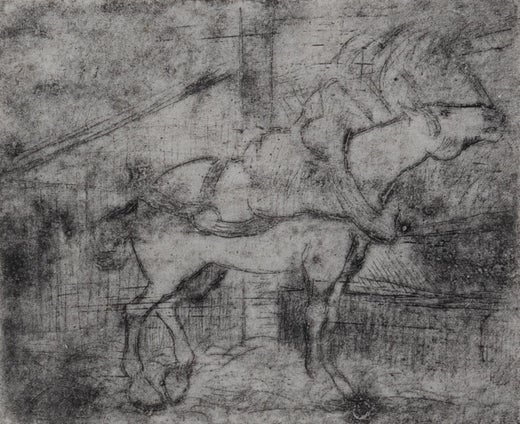Félix PissarroHorse Pulling Hay Cart by Félix Pissarro - Animal etching circa 1890
circa 1890
About the Item
- Creator:Félix Pissarro (1874 - 1897, French)
- Creation Year:circa 1890
- Dimensions:Height: 7.68 in (19.5 cm)Width: 5.91 in (15 cm)
- Medium:
- Movement & Style:
- Period:
- Condition:
- Gallery Location:London, GB
- Reference Number:1stDibs: LU26129457082
Félix Pissarro
Félix Pissarro, known within his family as Félix II, so as not to confuse him with his beloved uncle Félix, after whom he was named, was born in September 1917 in Beynac in the Dordogne. Félix II was the grandson of Camille Pissarro and son of the well-established artist Georges Manzana and Blanche Moriset (also known as Roboa), a well-reputed pastel painter. Having grown up in such an artistic milieu, and under the artistic guidance of his parents, Félix went on to become one of the most active artists of this third generation of Pissarro painters. The contributions of each of these generations of Pissarro artists over 165 years helped to make the family one of the most preeminent families in the history of art of the 20th century.
Félix spent his formative years living in Les Andelys in Normandy but was forced to leave in 1939, when, at the outbreak of the war, Manzana decided to move his family to Casablanca in North Africa, where they stayed until 1947. Despite the foreign setting and the tumultuous period, during this time Félix often exhibited his early works alongside his parents. After the death of his mother in 1949, Félix moved briefly to Paris with his father before they returned to Les Andelys, all the while developing a close working relationship with his father. Félix was particularly close with Manzana, who would continue to be his mentor throughout his career. Indeed, even following Manzana’s death, Félix continued to execute his paintings using the artistic traditions that his father had taught him, while simultaneously developing his own individual style. This unique style is most visible in his pastel drawings and sketches that seem to reflect the haste and spontaneity of the Impressionist painters.
Nature and pastoral settings dominate Félix’s oeuvre, and he was clearly influenced by the landscape around him. In 1953, Félix married Marie-Louis Monvoisin, and together with Manzana, they moved first to Negresco in Nice, before settling into a hillside home in the idyllic town of Menton on the Côte d’Azur near the Italian border. Father and son would often paint here together. In this hillside setting, Félix frequently chose to depict the forests near his home. Both his vibrant pastels and oil paintings, as well as his charcoal sketches, convey the dappled light through the leaves in the forest and the density of the foliage. These landscapes are perhaps even reminiscent of his uncle Paulémile’s lush and verdant landscapes. In 1978, due to an illness, Félix left his hillside home and moved to a home closer to Menton, which looked onto the sea. This view of the seaside featured prominently in his works during this period. Despite Félix’s evident preference for the tranquillity of a rural lifestyle, he frequently participated in shows over the course of his career. While living in the respective places, he had shows at the Biennale in Menton and the Negresco in Nice. Furthermore, he was a long-standing exhibitor at the Trianon Gallery in Nice.
(Biography provided by Stern Pissarro Gallery)
- ShippingRetrieving quote...Ships From: London, United Kingdom
- Return PolicyA return for this item may be initiated within 7 days of delivery.
- Man & Beast by Orovida Pissarro - EtchingBy Orovida PissarroLocated in London, GB*UK BUYERS WILL PAY AN ADDITIONAL 20% VAT ON TOP OF THE ABOVE PRICE Man & Beast by Orovida Pissarro (1893-1968) Etching 27 x 22 cm (10 ⁵/₈ x 8 ⁵/₈ inches) Signed and dated lower right, orovida 1924 Inscribed lower left, Final state no 12/40 and titled lower centre Artist biography: Orovida Camille Pissarro, Lucien and Esther Pissarro’s only child, was the first woman in the Pissarro family as well as the first of her generation to become an artist. Born in Epping, England in 1893, she lived and worked predominantly in London where she became a prominent member of several British arts clubs and societies. She first learned to paint in the Impressionist style of her father, but after a brief period of formal study with Walter Sickert in 1913 she renounced formal art schooling. Throughout her career, Orovida always remained outside of any mainstream British art movements. Much to Lucien's disappointment she soon turned away from naturalistic painting and developed her own unusual style combining elements of Japanese, Chinese, Persian and Indian art. Her rejection of Impressionism, which for the Pissarro family had become a way of life, together with the simultaneous decision to drop her famous last name and simply use Orovida as a ‘nom de peintre’, reflected a deep desire for independence and distance from the weight of the family legacy. Orovida's most distinctive and notable works were produced from the period of 1919 to 1939 using her own homemade egg tempera applied in thin, delicate washes to silk, linen or paper and sometimes embellished with brocade borders. These elegant and richly decorative works generally depict Eastern, Asian and African subjects, such as Mongolian horse...Category
1920s Post-Impressionist Animal Prints
MaterialsEtching
- Rupert Rides by Orovida Pissarro - Animal etchingBy Orovida PissarroLocated in London, GB*UK BUYERS WILL PAY AN ADDITIONAL 20% VAT ON TOP OF THE ABOVE PRICE Rupert Rides by Orovida Pissarro (1893-1968) Etching 31 x 23.5 cm (12 ¼ x 9 ¼ inches) Signed and dated lower righ...Category
1950s Post-Impressionist Animal Prints
MaterialsEtching
- Curves by Orovida Pissarro, 1919 - Etching PrintBy Orovida PissarroLocated in London, GBCurves by Orovida Pissarro (1893 - 1968) Etching, trial proof no. 54 20.2 x 15 cm (8 x 5 ⅞ inches) Signed and dated lower right, Orovida 1919 Inscribed lower left Trial proof no. 54 ...Category
1910s Post-Impressionist Animal Prints
MaterialsPaper, Etching
- Procede by Georges Manzana Pissarro - Monotype of a birdBy Georges Henri Manzana PissarroLocated in London, GBProcede by Georges Manzana Pissarro (1871-1961) Coloured monotype with gold, silver and pencil 24 x 30 cm (9¹/₂ x 11³/₄ inches) Signed lower right, Manzana Artist biogaphy Like all ...Category
20th Century Post-Impressionist Animal Prints
MaterialsGold, Silver
- Three Hens by Georges Manzana Pissarro - Animal stencilBy Georges Henri Manzana PissarroLocated in London, GBThree Hens by Georges Manzana Pissarro (1871-1961) Pochoir 31.8 x 48.3 cm (12 ½ x 19 inches) Signed with Estate stamp and épreuve d'état Provenance Private Collection, London Artis...Category
19th Century Post-Impressionist Animal Prints
MaterialsStencil
- The Green Woodpecker by Georges Manzana Pissarro - Animal stencilBy Georges Henri Manzana PissarroLocated in London, GB*UK BUYERS WILL PAY AN ADDITIONAL 20% VAT ON TOP OF THE ABOVE PRICE The Green Woodpecker by Georges Manzana Pissarro (1871-1961) Pochoir 31 x 47 cm (12 ¹/₄ x 18 ¹/₂ inches) Signed w...Category
1920s Post-Impressionist Animal Prints
MaterialsStencil
- Lithograph Lady Rider Woman on a Horse Marie Laurencin French Post ImpressionistBy Marie LaurencinLocated in Surfside, FLMarie Laurencin (French, 1883-1956) Lithograph of a colored pencil drawing depicting a woman wearing a hat and riding horseback side saddle, Edition "37/115" to lower left and hand signed "Laurencin" in pencil to lower right, with a cloth mat and housed in a silvered wood frame. Dimensions: Image, 12" H x 16" W; frame, 19.75" H x 23.5" W x 1.5" D. Marie Laurencin (1883 – 1956) was a French painter and printmaker. She became an important figure in the Parisian avant-garde as a member of the Cubists associated with the Section d'Or. Laurencin was born in Paris, where she was raised by her mother and lived much of her life. At 18, she studied porcelain painting in Sèvres. She then returned to Paris and continued her art education at the Académie Humbert, where she changed her focus to oil painting. During the early years of the 20th century, Laurencin was an important figure in the Parisian avant-garde. A member of both the circle of Pablo Picasso, and Cubists associated with the Section d'Or, such as Jean Metzinger, Albert Gleizes, Robert Delaunay, Henri le Fauconnier and Francis Picabia, exhibiting with them at the Salon des Indépendants (1910-1911) and the Salon d'Automne (1911-1912), and Galeries Dalmau (1912) at the first Cubist exhibition in Spain. She became romantically involved with the poet Guillaume Apollinaire, and has often been identified as his muse. In addition, Laurencin had important connections to the salon of the American expatriate and lesbian writer Natalie Clifford Barney. She had relationships with men and women, and her art reflected her life, her "balletic wraiths" and "sidesaddle Amazons" providing the art world with her brand of "queer femme with a Gallic twist." Laurencin's oeuvre include painting, watercolor paintings, drawing, and prints. She is known as one of the few female Cubist painters, with Sonia Delaunay, Marie Vorobieff, and Franciska Clausen...Category
Mid-20th Century Post-Impressionist Animal Prints
MaterialsLithograph
- Monkey (Edition 33/100 Dated 1959)Located in Sydney, NSWArtist: Thomas Cornell (American 1937-2012) Title: Monkey (Edition 33/100 Dated 1959) Medium: Etching on paper Condition: This work is in good condition, in its original frame. Provenance: Private Collection New York About: Cornell was known for empirical drawings and paintings. His work involved moral content concerning global, social, and environmental justice. He was the Richard E. Steele Artist-in-Residence at Bowdoin College...Category
Mid-20th Century American Modern Animal Prints
MaterialsEtching, Paper
- Feeling PricklyBy Jenny TothLocated in Brooklyn, NYThis is an artist proof (one of a kind) etching of a woman with a cactus growing in and out of her. Whimsical and both funny and thoughtful, the composition is both rhythmic and pow...Category
2010s Contemporary Figurative Prints
MaterialsPaper, Ink, Archival Ink, Etching
- Finger Parrot, monochromatic print bold graphic, surreal bird, handsBy Jenny TothLocated in Brooklyn, NYThis is an artist proof (one of a kind) aquatint of a parrot made up of fingers, and beautiful insects cascading to her right. She has a human ear on one side. The images is 6 x 6 ...Category
2010s Contemporary Figurative Prints
MaterialsPaper, Ink, Archival Ink, Aquatint
- Bulls, Skulls, and Tears, monochromatic linear animals bonesBy Jenny TothLocated in Brooklyn, NYThis is an artist proof (one of a kind) etching of a woman peaking behind a bull's skull with other live bulls dancing around behind. The work has movement and a feeling of a circle...Category
2010s Contemporary Figurative Prints
MaterialsPaper, Ink, Archival Ink, Etching
- Ducks Quacking, Cactus Peeking, linear style, monochromaticBy Jenny TothLocated in Brooklyn, NYThis is an artist proof aquatint of a woman peeking around a cactus with ducks mysteriously hovering in the upper right corner and a giant beautiful cactus overgrowing. The mood is ...Category
2010s Expressionist Figurative Prints
MaterialsPaper, Ink, Archival Ink, Aquatint
